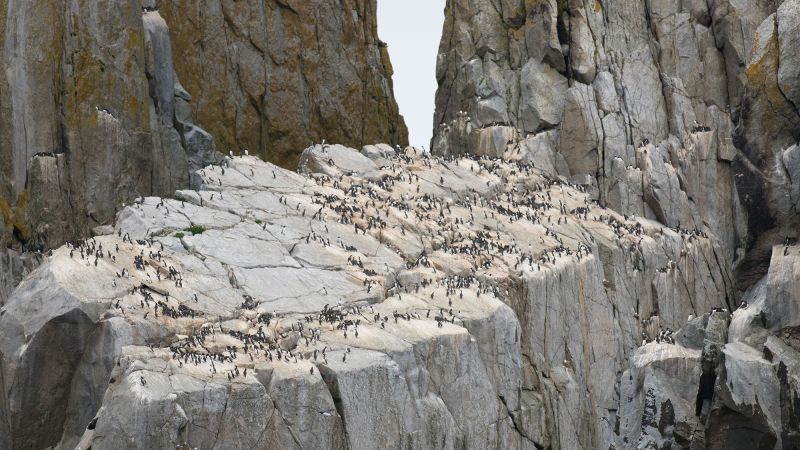In a startling revelation, a recent study has highlighted a devastating impact caused by a marine heat wave that struck Alaska, resulting in a catastrophic loss of the common murre population. Approximately 50% of this species, known scientifically as Uria aalge, suffered mortality, marking the largest documented die-off within a single species in modern history. The findings indicate that the rising ocean temperatures, a consequence of changing climate patterns, are reshaping marine ecosystems and critically hindering the survival chances of various marine species.
The so-called Northeast Pacific heat wave, colloquially referred to as “the Blob,” persisted across the ocean ecosystem from California to the Gulf of Alaska from late 2014 to 2016. This significant event is recognized as the most extensive and longest marine heat wave ever recorded. Temperatures soared by 2.5 to 3 degrees Celsius (approximately 4.5 to 5.4 degrees Fahrenheit) above the average levels. According to Brie Drummond, one of the study’s authors, this alarming temperature increase has dire implications for marine life, including the common murre, a seabird pivotal to the marine food web in the Northern Hemisphere.
Historically, common murres have endured smaller population declines attributable to various environmental shifts and human-induced influences. Nevertheless, they have typically shown a remarkable capacity to rebound as conditions improve. The current study raises concerns, as the scale and rapidity of the recent die-off were unprecedented, signaling a potentially irreversible change in their environments. Drummond and her research team assessed the extent of the murre population decline by monitoring 13 long-term colonies throughout the Gulf of Alaska and Bering Sea, ultimately discovering over 62,000 carcasses by the 2016 heat wave’s conclusion. This figure, however, represents only a fraction of the actual losses, with many deceased seabirds never washing ashore.
Following the heat wave, the biologists tracked the murres’ population trends and reproduction rates but found no evidence of recovery. The only reason the research team could detect this significant event was due to the extensive long-term data sets available. Drummond emphasized that ongoing monitoring will be essential for understanding future shifts in populations. The collapse of crucial food sources, particularly Pacific cod, which plummeted by roughly 80% between 2013 and 2017, severely impacted the murres. Between 2014 and 2016, researchers estimate that around 4 million common murres perished in Alaska, a staggering comparison likened to losing half of New York City’s population in a single harsh winter.
Before the heat wave, Alaska’s common murre population constituted 25% of the global numbers for this species. However, a stark comparison between the population metrics of the seven years prior to the heat wave (2008-2014) and those in the subsequent years, from 2016 to 2022, revealed a shocking decline ranging from 52% to 78% across the monitored colonies. Continued monitoring from 2016 through 2022 has not indicated signs of recovery for the species.
The reasons for the failure to rebound remain unclear and merit further investigation. Shifts in the marine ecosystem appear to play a significant role, especially concerning the availability of food sources. Additional challenges such as reproduction difficulties and habitat relocation may exacerbate the dire situation. Dr. Falk Huettmann from the University of Alaska, who was not involved in the particular study, indicated that seabirds like murres have longer reproductive cycles, making population recovery a slow progression. These seabirds are also tethered to specific colonies, complicating their adaptation to new environmental conditions.
As Alaska continues to witness rising temperatures, tropical or subtropical marine conditions are encroaching, inviting potentially radical changes in local ecosystems. This indicates that species must either adapt to the newly evolving environment or risk extinction. The tufted puffin and other marine species are also feeling the pressure; they are migrating northward due to deteriorating habitat conditions elsewhere, though with limited success in adaptation.
Interestingly, while many species experience declines due to heat waves, some others show resilience. Analyzing various organisms, researchers found that 50% of collected data reflected neutral responses to the heat wave, with 20% of apex predators even exhibiting positive reactions. Drummond articulated that understanding which marine species are more adaptable to warming waters is crucial for future ecological forecasts.
The interplay of rising temperatures, along with compounded stress factors like microplastics, ocean acidification, and oil spills, adds complexity to the mortality rates among marine life. However, comprehensive studies tracing long-term ecological changes remain scarce, leaving many uncertainties about how species will be affected moving forward. As our understanding of these ecological challenges expands, it becomes increasingly critical to devise strategies to mitigate impacts and sustain marine populations in the face of climate change.



